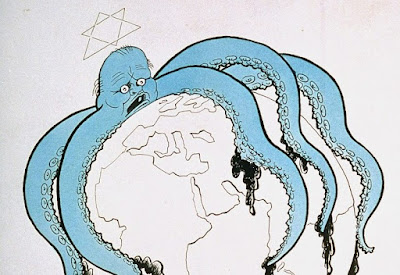Source: https://www.renegadetribune.com/the-kraken-the-octopus-and-the-jews/
by Karl Radl
In this brief article I want to discuss the image of the Octopus that is so often used in anti-jewish propaganda. Indeed the use of the octopus motif is so common in anti-Semitic cartoons and art that jews have often commented on the ‘negative zoological morphology’ of this image and the suggestion that the jews are inhuman, alien and have their influence everywhere. (1)
The origin of the octopus in anti-jewish propaganda probably has its genesis in the use of negative animal comparisons such as are common in medieval references to jews (for example ‘Judensau’/’Jewish Pig’) as well as Islamic ones (hence the famous reference in Qur’an to jews being descendants of ‘apes and pigs’).
The problem with locating a purely gentile origin for this is the fact that jews originate both the ‘apes’ and the ‘pigs’ claims by seeing non-jews as being less than human/humanoid (i.e., ‘apes’) and those who did and/or consumed things forbidden by the creator of the universe (i.e., ‘pigs’) in their own work that predates Christian and Islamic characterisations of them along similar lines.
It is indeed ironic that jews – especially those of Zionistic sympathies – frequently decry such imagery given that its basis is found in Judaism, but with jews calling non-jews by these names rather than the other way around. I will discuss the issue of the jewish origins of the ‘apes and pigs’ comment in the Qur’an in a separate article, but for our purposes: it is enough to state that the negative zoological comparisons used to illustrate and propagate anti-jewish beliefs derive their inspiration from the jews themselves.
The most common is, of course, the jewish snake or serpent (which the Tanakh is somewhat obsessed with as a negative jewish image in relation to non-jews and/or polytheism) (2) that probably derives as an anti-jewish image from the symbolism of the eating of the forbidden fruit by Eve encouraged by a snake when connected to the popularly-believed direct connection (heavily fostered by enterprising members of the tribe) made between jews and the practice of secret/forbidden/black magic.
Essentially the jews were guilty of tempting the non-jews with forbidden fruit that would lead to increased/increasing distance from God and it is little surprise that the common association of snakes with anti-jewish imagery comes largely from the use of such images by populist French anti-Semites like Drumont in the mid-late nineteenth century and that he – and many of his intellectual circle and readership – were devout Catholics.
The reptilian negative anti-jewish image was then given form and lent itself beautifully to being artistically rendered as frontispieces for editions of the Protocols of Zion and the like. However the limitation of the reptilian imagery was that it lacked the scope of being artistically rendered so as illustrate the many-faceted nature of jewish power.
To do that a new negative animal comparison was needed and that comparison was easily found: the octopus. With its alien many-armed appearance it was ideal for illustrating the nature of jewish power by giving it form in a known creature.
However there are limitations to this anti-jewish rendering of the octopus as an artistic metaphor for jewish power. The principal one is that an octopus is a neutral creature to most people (in fact I rather like octopuses) and this suggests that jewish power is neutral in terms of being a force for good/evil or simply benign even if one recognizes its scope and scale.
Thus perhaps a slight change is in order (and one that came to me while reading Victor Hugo’s ‘Toilers of the Sea’) and rather than an octopus. We need to look to its mythic (although probably based on real encounters with dead/barely alive giant/colossal squid) equivalent: the Kraken.
The Kraken has the many arms and the alien nature of the octopus, but it importantly is almost universally regarded as a negative comparison. People might think octopuses are harmless, but they certainly regard the Kraken as dangerous in the extreme.
This danger highlights the general utility of the Kraken image, because it is associated with a large size (i.e., the sheer scale of jewish power), is highly aggressive (i.e., the willingness to jews to use their power for their own individual and group advantage) as well as being instantly recognizable to any viewer of the image.
You don’t generally think of an octopus as dangerous, but the Kraken is certainly a threat and that is how we need to portray anti-jewish images to a mass audience: in that they need to play on their cultural knowledge base (the widely-known stories about the Kraken) while evoking the correct ideas in relation to their subject (the alien, powerfully aggressive and many armed nature of the Kraken) and provoking the appropriate negative/fear reaction that the image is trying to convey to them (i.e., the threat posed to them personally by the Kraken).
Portraying jewish power as the Kraken; as opposed to an octopus, is thus more appropriate: is it not?
Thank you for reading Semitic Controversies. This post is public so feel free to share it.
References
(1) For a sample discussion see Jeffrey Herf, 2006, ‘The Jewish Enemy: Nazi Propaganda During World War II and the Holocaust’, 1st Edition, Harvard University Press: Cambridge, pp. 1-12
(2) For further reading please see Karen Joines, 1974, ‘Serpent Symbolism in the Old Testament: A Linguistic, Archaeological, and Literary Study’, 1st Edition, Haddonfield House: United States




No comments:
Post a Comment